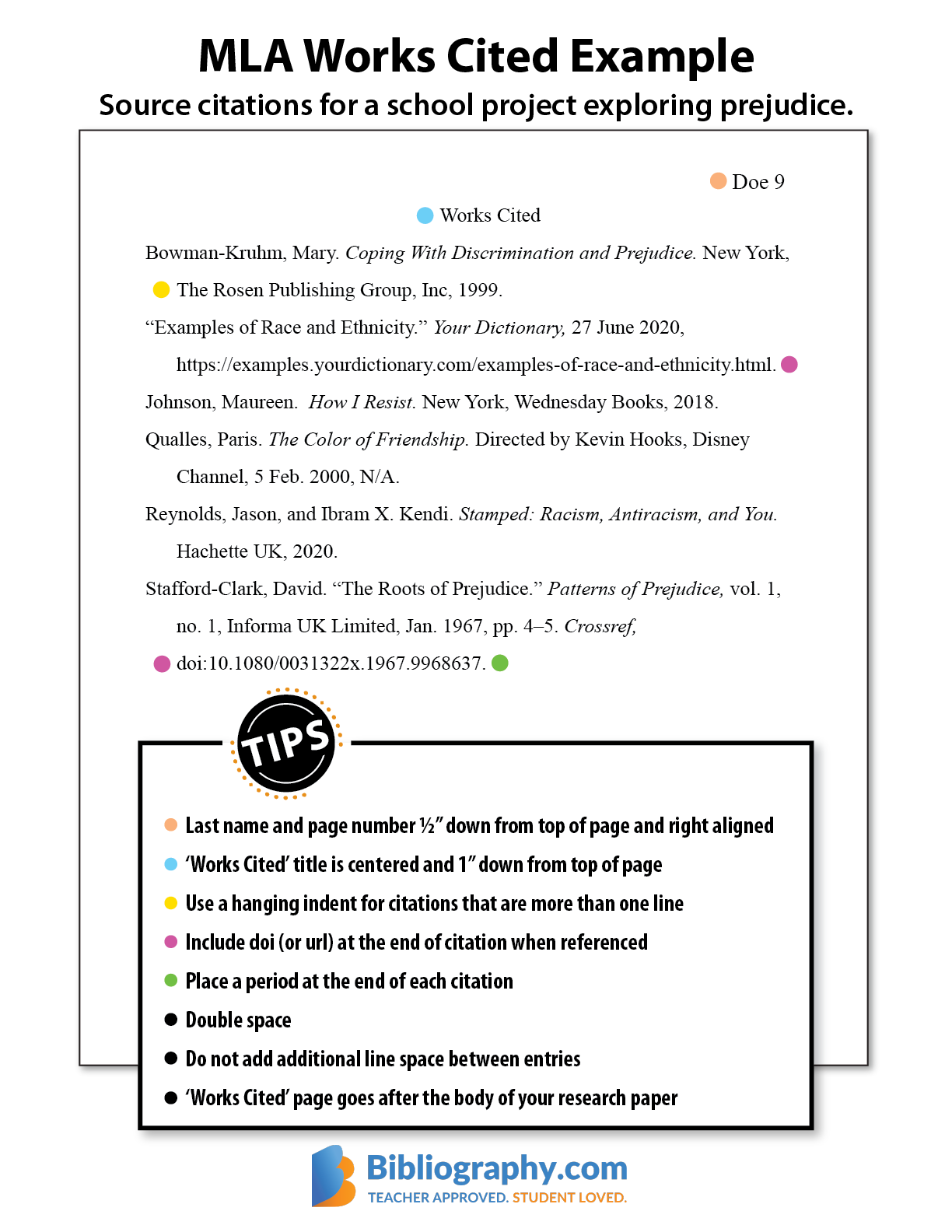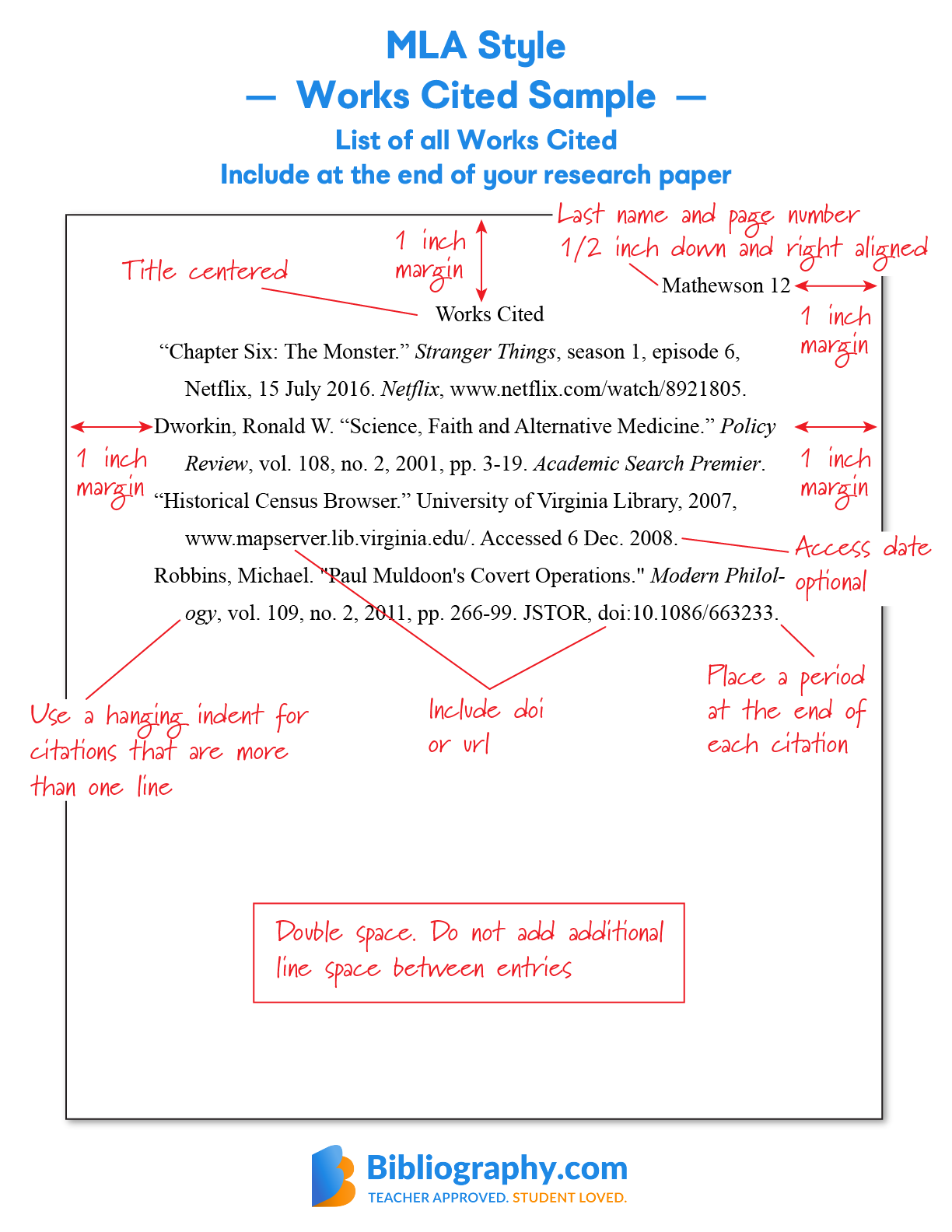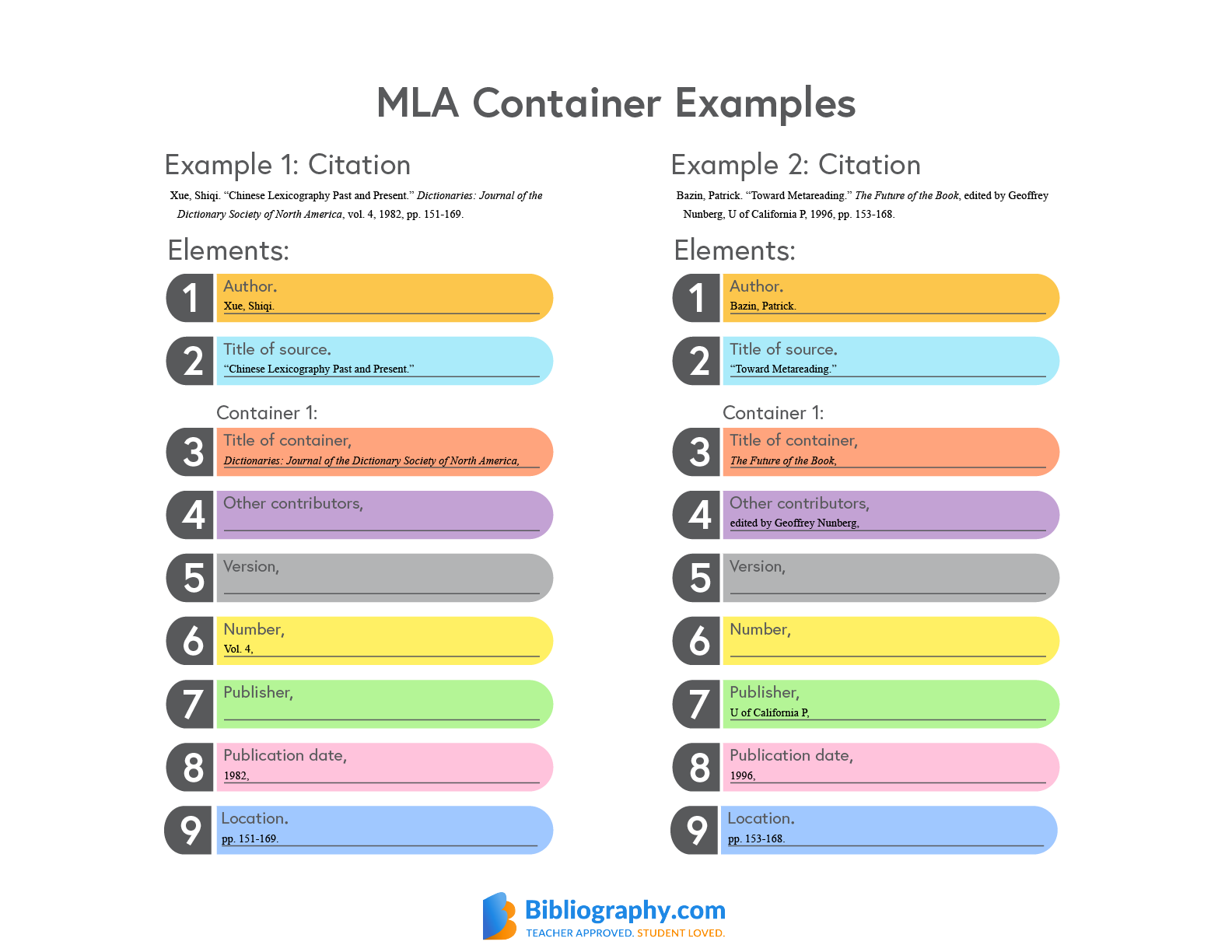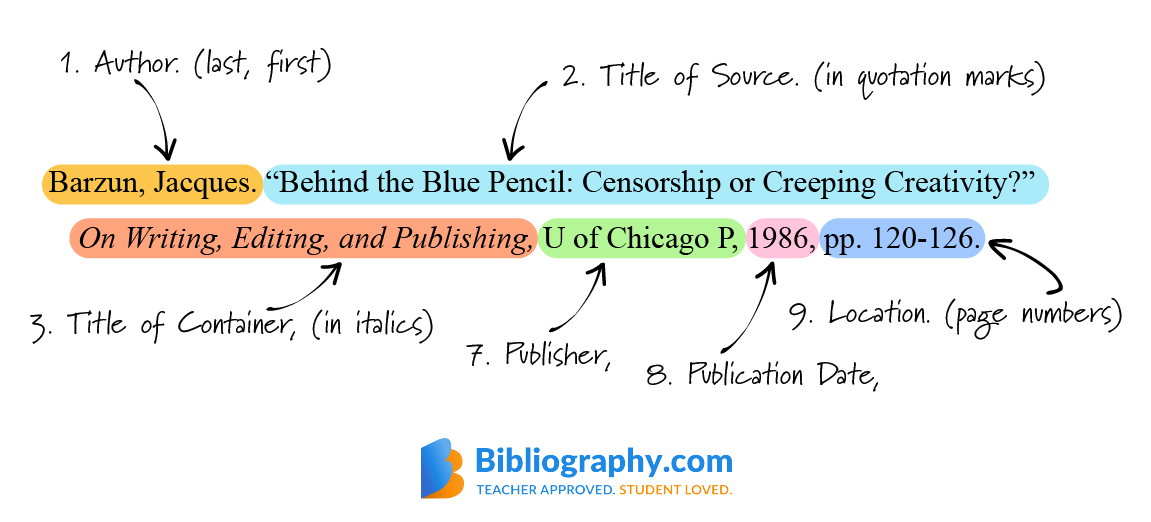How To Create A Works Cited Page Mla Format
Your paper is perfect! All your in-text quotes have a citation, the formatting is top-notch, and you're now breathing a sigh of relief. Until you realize you don't have a works cited. Don't lose your cool. You have the research and the paper. Now, just follow the MLA 8 works cited page example below as a guide to create your own.
How to Do a Works Cited Page
A works cited page is the last page of your MLA style paper. It follows a specific format for citations set forth by the Modern Language Association using a unique nine core element system. The system used by the Modern Language Association is designed to make creating citations for websites and other commonly used humanities research sources simple.
It'll include the references used to create the essay, dissertation, or thesis you've written. You'll start your works cited on its own page. The last name and page number header will be at the top, along with the title: Works Cited. Unlike the rest of the page that will be aligned to the left, your title will be centered.
Example of Works Cited Page
You know how to outline your paper; it is time to see them in action. Check out an example to get you rolling. The example is offered in a downloadable PDF format for your convenience.


Works Cited vs. Bibliography
Your works cited is your bibliography page, right? Nope. A works cited is different from a bibliography.
While both will be at the end of your paper and provide your resources to your audience, a works cited will only list the references used in the article. The bibliography covers everything. In a bibliography, you'll list the works that sparked your ideas, even if you didn't use them in the paper. Now, you know that a bibliography isn't an umbrella term to cover all reference sheets. It's a specific type of reference sheet. So, it's time to look at how to create an MLA works cited page.
Works Cited Outline
When you create your works cited, there are specific rules that must be followed.
- All references will be double spaced.
- References that go onto a second or third line will have a hanging indent that is 0.5 inches from the left margin.
- All the references that you include in your works cited will end with a period, even if they are a website.
- The titles of books, articles, and similar sources will use header capitalization and be italicized (e.g., Pride and Prejudice).
- Online sources need a URL, but no http://. Use a DOI if available.
- Author's full names are listed, but they are inverted with last name first (e.g., Smith, Sam Kenny).
- No titles should be listed, like Dr. or Ph.D., but you should include suffixes like Jr.

Title and Heading Format
Your title and heading format come in two parts.
- Title – "Works Cited" centered on the top. It will not be larger, bold, or italicized.
- Header – last name and page number ½ inch down and right-aligned. Your running header includes consecutive page numbers throughout. Typically, your Works Cited is the last page.
Most of the time, your title page is labeled Works Cited. However, there are a few particular circumstances where the title you use will change.
- Work Cited – 1 source
- Works Cited – 2 or more sources
- Works Consulted – includes all sources cited and consulted to write the paper
Sometimes, instructors might ask you to create a bibliography rather than a reference list. This means you'll include all the sources used in creating your paper instead of just the ones you cite in your in-text citations in the body of your essay. In this instance, your title becomes "Works Consulted." Since you consulted all these works, it makes more sense.
Alphabetizing Your Works Cited
Alphabetizing your works cited is pretty easy; it's merely alphabetical order. Therefore, whether you use an author's last name, title, or corporation, everything goes alphabetically.
Simple Alphabetizing Example
Doe, Jane
Does, John
Ewald, Lisa
Where things can get a little tricky or confusing is when you have multiple authors or numbers. MLA is nothing if not thorough and covers those situations as well.
- Same author, different titles – alphabetize by title.
- Same primary author, different co-authors – alphabetize by the co-author's last name.
- Titles – ignore articles a, an, the, and alphabetize
Complex Alphabetizing Citation Example
Galvin, Sarah M., and Debbie Guba, editors. Imaginings of the Modernist. Dorn and Breach Publishers, 1999.
Galvin, Sarah M., and Andrea Larma." Sexual Linguistics: Sexuality and Gender." New Literary History, vol. 16, no. 3, Spring 1999, pp. 415-26.
Arranging Numbers
Arranging numbers in your works cited is another area that needs some special consideration. Why? Because numerals in MLA formatting are alphabetized as if they were spelled out. Therefore, if you were to cite the book 1984, you would alphabetize it as if it said nineteen eighty-four.
Number Example Citation Entry
Orwell, George. Animal Farm. Wyatt North Publishing, LLC., 1996.
—.1984. Houghton Mifflin Harcourt, 1983.
—.The Road to Wigan Pier. Secker & Warburg, 1965.
Works Cited Punctuation
Punctuation in a works cited can quickly get confusing. Knowing whether you should add a comma or period can be enough to make your head spin. Thankfully, MLA is all about flexibility and simplicity. Therefore, you usually only have to worry about periods and commas. In addition to having a period at the end of a citation, MLA has a period after the author and title. Commas separate the other elements.
Works Cited Punctuation Example
Lee, Harper. To Kill A Mockingbird. Cornerstone, 1989.
Creating a Hanging Indent
When a citation goes into a second, third, fourth, etc. line, you need to create a hanging indent. The ½ inch indent works to inform the reader where one citation ends and the other begins.
Hanging Indent Example
Steel, Tomas J., D.B., and Ryan A. Daniels. Exploration of Hispanic Folklore, 1797 – 1947. Santa Fe: Ancient City Press, 1999
Listing Authors in an MLA Works Cited
The last of the formatting rules for your MLA Works Cited page is how to deal with listing authors. When you are using scholarly books and journals, you find that some of them have dozens of authors. Thankfully, MLA does not expect you to write them all out. Instead, they lay out how to write out multiple authors easily. For works with two names, you list them out. However, for three or more authors, you list only the first author and et al.
MLA Author Citation Examples
One Author:
Last name, first name
Betts, Jennifer
Two Authors:
Last name, first name, and first name last name
Betts, Jennifer, and Adrienne Mathewson
Three or More Authors:
Last name, first name, et al.
Mathewson, Adrienne, et al.
Works Cited: How to Create Citations
With the formatting rules out of the way, it's time to get into the works cited page's real meat and potatoes, the creation of the citations. MLA formatting is pretty unique in that it simplified the way you create your works cited page in their 8th edition. How they did that was through the use of the core elements and container system.
MLA Nine Core Elements & Containers
The MLA nine core element system includes:
- Author.
- Title of the sources.
- Title of the container,
- Other contributors,
- Version,
- Number,
- Publisher,
- Publication date,
- Location.

In the MLA citation system, elements three through nine make up the information of the container. The container is what shows you where to find the source. Now that you know about the elements and container system, check out MLA's nine core elements in detail.
Author.
The author is listed last name, full first name, and middle initial. Remember to include commas and end with a period. If there are two authors, include them in the order they are presented in the work. The second author is listed by the first name, then the last name, not by last name, first name.
The author refers to whoever produced the work. If you have an editor rather than an author, use this format: Last Name, First Name, editor. Listing a corporate author works much the same way.
Bloomberg. Economics of France. Taylor and Francis, 2002.
Title of Source.
Type titles exactly as they are found in the source. Italicize both the title and subtitle.
Sloan, Anton. Graphic Design: How to Create Beauty. U of New Mexico P, 2010.
The title of an essay, story, or poem in a collection, as part of a larger whole, is placed in quotation marks.
Barzun, Jacques. "Behind the Blue Pencil: Censorship or Creeping Creativity?" On Writing, Editing, and Publishing. U of Chicago P, 1986, pp. 120-126.
The title of the periodical (journal, magazine, newspaper) is set in italics, and the title of an article in the periodical is set within quotation marks.
Note: Place periods or other punctuation within quotation marks.
Xue, Shiqi. "Chinese Lexicography Past and Present." Dictionaries: Journal of the Dictionary Society of North America, vol. 4, 1982, pp. 151-169.
Title of Container
Bazin, Patrick. "Toward Metareading." The Future of the Book, edited by Geoffrey Nunberg, U of California P, 1996, pp. 153-68.
In the example above, The Future of the Book is the container. The information that follows the container describes the container. The title of the container is italicized and followed by a comma.
Blake, Roger. "Seeing Red." The New York Times Book Review, 9 Nov. 2017, p.23.
In this example, the container is The New York Times Book Review. Within that container is an article titled "Seeing Red." The container is described by the date of publication and location (page number).
A television series is made up of episodes. Therefore, the title of the series is the container, and the name of the episode is part of that container. The container is described by relevant information about the episode (director, writer, etc.).
"The Talk." Black-ish, directed by Rebecca Asher, written by Vijal Patel, season 1, episode 2. ABC, 2014.
Note: Place periods inside quotation marks.
Other Contributors,
If the work has been edited or translated, include those contributors in this element. Other roles may include:
- adapted by
- directed by
- illustrated by
- introduction by
- narrated by
- performance by
Include translators and editors of scholarly editions and collections. Works originally published in another language are usually recorded in documentation because they play key roles. If there are several contributors to a project, include the ones that are relevant to your project. If you're writing about a television episode and focus on a key character, you can mention the series creator and actor who played that role.
Version,
Books may be revised, or there may be different versions of musical and film compositions, such as live versions, director's cuts, and unabridged versions. Alert your reader to the correct version you are citing by including that information in the entry.
Burchfield, R.W. Fowler's Modern English Usage. 3rd ed., Oxford: Clarendon Press, 2004.
Jean-Jacques Beineix, director. Betty Blue, 1986. Performance by Beatrice Dalle, director's cut, Cinema Libre Studio, 1993.
Number,
If the source is part of a numbered sequence, such as a volume of a book or journal issue, you'll need to indicate that number in your entry.
Journals
Journals usually have both volume and issue numbers. Typically, a volume consists of one year's issues and is numbered sequentially, starting with one. Issue numbers start at the beginning of each year and end at the end of the year.
- For example, a journal that's entering its 12th year and publishes monthly issues will start a new volume in January – vol. 12 starting with a new issue number for January. For example: vol. 12, no. 1.
However, some journals do not use volume numbers and will simply number their issues sequentially from the beginning. In that case, just use the issue number (e.g., no. 18). Comic books are numbered like journals with issue numbers.
Publisher,
Who you list as the publisher depends on the format of the source.
Books
You can find the publisher of a book on the title page or the copyright page.
Films and TV Series
Look for the entity that had the primary overall responsibility for producing the work, such as NBC or Warner Bros.
Websites
If the website is published by an organization, such as a library or university, you can find that information easily on the ABOUT or CONTACT page or on a copyright notice.
- Sites that host works are not publishers. For example, YouTube and Vimeo host videos, and databases such as ProQuest or DOAJ are also hosting services. Therefore, you don't need to list them.
- For academic presses, remember to abbreviate the publisher's name by replacing University Press with UP, such as Boston UP or U of New Mexico P.
Publication Date,
Sometimes you'll see various publication dates listed as the original object was published in various formats throughout the years. How do you know which one to use in your MLA citation entry? Choose the one that best fits your experience in finding that source. If you use an online source that also appears in print, use the online source's date as that's the actual object you are citing.
- For print sources, there is only one date but be careful to find the actual date of publication of the revision you consulted. The date is either on the title page or copyright page. Always use the most recent date listed. Refer to the actual book to find the date, as online booksellers or bibliographies may be inaccurate.
- List the full date, if available, for web comments, web articles, and other online content. If available, include the date a video was uploaded, too.
- Use the date printed on journals, magazines, and newspapers. If the full date is available, use that.
Again, remember the key is to make sure your reader can find the exact source you cited. Your entry is creating a path to that source.
Location.
The final piece of your entry is the location; therefore, you'll end it with a period.
- In print sources, the work's location is the page (s) number. Use p. or pp.
- Use the URL or DOI to indicate the location of a web source. Follow your instructor's guidance to determine whether to include links. If you do include a link, leave out the http/https section of the link.
- Indicate the name and city of physical objects such as a work of art – sculpture, painting, or artifact –listed in your entry. However, if the name indicates the city, don't repeat the city's name.
For example, if you're citing a piece of art at the Los Angeles County Museum of Art, the name alone is fine; however, to cite a piece of art at the Getty Museum, you will need to include the name of the city: Los Angeles.
Park, David. Two Women, 1957, Los Angeles County Museum of Art.
Walker, Kara. Christ's Entry into Journalism, 2017, Museum of Modern Art, New York.
Works Cited Citation Examples
The container system makes things easier for you when it comes to all your citations, but it's still helpful to see a few examples of tricky citations in action. This is especially true for citations like anthologies, religious texts, PowerPoint presentations, and images.
Website Citation Example
While journals and books make up a large portion of your research, website citations are becoming more and more common. A website citation example includes the author (if available), title, website, date, and URL.
Matheson, Andrienne, "MLA Website Citation Examples." Bibliography, 10 Aug. 2020, www.bibliography.com/mla/mla-website-citation-examples/.
Anthology Citation Example
Rather than just one book, an anthology is a collection of works like poetry or stories; therefore, citing an anthology is unique. To create an anthology citation, you need the author, essay title, collection title, editor's name, publisher, year, page entry.
Hughes, Langston. "Let America Be America Again." The Collected Poems of Langston Hughes, edited by Arnold Rampersad, Knopf, 2004, p. 58.
Bible Citation Example
MLA is unique in that it is one of the only citation styles that requires you to cite the Bible and other religious texts. Since it is necessary, it's essential to know how to do it through Bible citation examples. For a biblical entry, you need the title of the Bible, version, editor, publisher, and year.
The Bible. Authorized King James Version, Oxford University Press, 2010.
Media Citation Example
When it comes to citing media like movies and tv, you don't have an author. But you do have a producer or director. Therefore, your citation includes the title, contributors, publisher, production company, and year of release.
Star Wars: The Rise of Skywalker. Directed by J.J. Abrams, Lucasfilm, 2019.
Interview Citation Example
Personal accounts and interviews make excellent sources for your paper, but they can be tricky when it comes to your citation. To keep things simple, just follow the container system.
Email Interview Example
Denver, Rudolfo. "Re: Banning in Chicago." Received by Lenard Dalli, 4 June 2020. Email Interview.
Image Citation Example
Citing images isn't hard. There are just a lot of different types out there. Therefore, you have to rely on the container system to get you through when it comes to the artist name, title, date, publisher info, and URL.
Personally Taken Image Citation
Simpsons, John. Sunset on the Pacific. 2010, Chicago Museum of Art, Illinois.
Play Citation Example
Last, but certainly not least, is the play citation. MLA works excellent for analysis of Shakespeare or any other great playwright, so knowing how to cite a play is essential. Again, it comes down to knowing your containers, but typically, a play includes the playwright, play title, publisher, and year for published plays.
Published Play Example
Williams, Tennessee. A Streetcar Named Desire. Faber, 2019.
Crafting Your Works Cited
MLA works cited pages can seem overwhelming. But, if you follow the MLA format guidelines, making your works cited page can be a breeze. Now get citing so your paper will be the epitome of perfection.
Works Cited Examples and Formatting Tips
How do you do a MLA works cited page?
To create an MLA works cited page, you need to create citations using the MLA core elements system and place all your citations in alphabetical order with a hanging indent. Additionally, you will title your works cited page "Works Cite".
Do you include URL in MLA works cited?
Yes, in your MLA works cited entry, you will include a URL for the website where the source is found for websites, media, and other online sources.
What is MLA format example?
MLA format is the writing style created by the Modern Language Association; therefore, an example of MLA format follows the guidelines set forth by MLA including 1-inch margins, running page number, indented paragraphs, and a works cited. There are also specific rules for the set up of the works cited page.
What does MLA works cited look like?
An MLA works cited looks like a list of citations for all the references used in the body of the paper. Each different in-text citation corresponds with a citation in the reference list. The MLA format citations use the core elements system so each different citation type is unique.
How do you cite Macbeth MLA works cited?
To cite Macbeth in your MLA works cited, you need the playwright, play title, publisher, and year. A Macbeth works cited example looks like:
Shakespeare, William. Macbeth. The Floating Press, 2009.
How To Create A Works Cited Page Mla Format
Source: https://www.bibliography.com/mla/works-cited-page-example/
Posted by: carterthreatin1945.blogspot.com


0 Response to "How To Create A Works Cited Page Mla Format"
Post a Comment